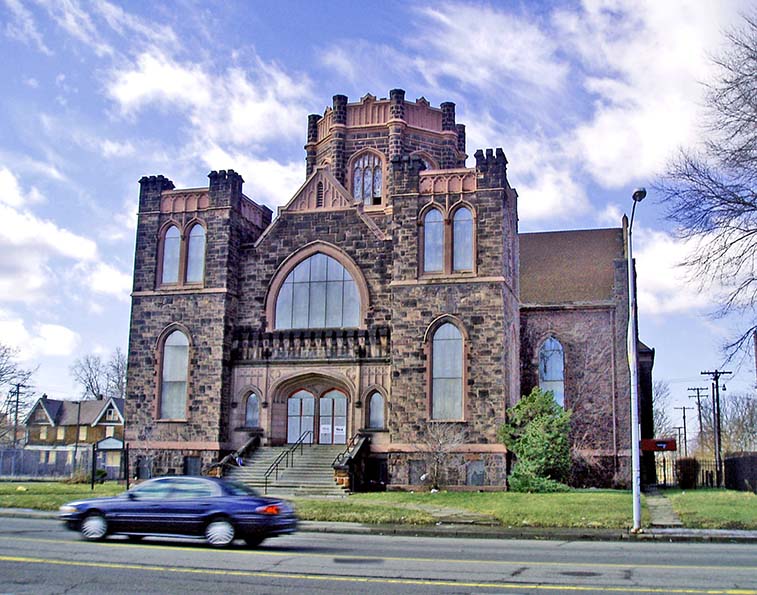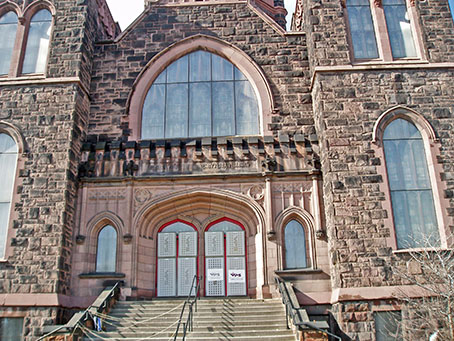

This is one of the most massive churches in Detroit. For many decades it was the home of the oldest Protestant congregation in Michigan. As the city's population grew slowly in the years after the stalemate ended the War of 1812, Father Gabriel Richard found himself ministering to Protestants as well as Catholics. He, territorial governor Lewis Cass, and Judge Augustus Woodward convinced a young graduate of the Princeton Theological Seminary—the Reverend John Montieth—to come to Detroit in 1817. Reverend Montieth was the first Protestant minister to work in Detroit and served as the first president of the Catholoepistmied that Father Richard founded—the school that became the University of Michigan. Churches have traditionally carried out charitable work. First Presbyterian is the congregation that founded Harper Hospital in the 19th century.
Detroit Protestants, presumably under the leadership of Reverend Monteith, formed the First Evangelical Society. I believe this evolved into First Presbyterian Church. In 1825, that organization was formally chartered by the territorial government. By that time, Reverend Monteith was no longer in Detroit. I believe he left in 1821 to take a job teaching school in the east and then moved on to become a professor at Hamilton College in Clinton, New York. John Monteith lived until almost 1880 but, after leaving Detroit, I think he had no further contact with the University where he served asw president or the Presbyterian congregation that he helped establish in Detroit.
The Presbyterians held services in the early- and mid-Nineteenth Century in several location in downtown Detroit but that land appreciated in value. Just as the Catholics found that they could sell the property that held their St. Anne de Detroit Church and raise funds to build elsewhere, so too, the Presbyterians sold their land in downtown Detroit and purchased the property you see at Woodward and Edmund Place.
This edifice may be the finest work of the Detroit
architects George DeWitt Mason and Zecariah Rice. Henry Hobson Richardson
is though t by many
to be the nation's most accomplished architect of the late 19th century. First
Presbyterian in Detroit is modeled after Hobson's Trinity Church in Boston. Apparently the Detroit architect traveled to Boston to study the design of Trinity Church.
It
is a large red rough-cut stone building. The substance is red Portage limestone from Houghton. The interior is in the form of
a Greek cross. In the Greek cross, all four arms are of the same length but the Latin cross—used as a model for many Gothic churches—has three short and one long arm. Huge masonry arches support a massive tower in red sandstone
that is buttressed by substantial turrets at each corner. This tower—90 feet in height—is capped
with a steep slate roof with gabled dormers. This church includes an exceptional
array of stained glass windows, many but not all of them, by Tiffany. One of
the most impressive shows the Star of David surrounded by the tongues of
fire
that descended upon the Apostles as they gathered together the day of Pentecost. Another window
commemorates the first sermon that the Reverend Montieth gave in Detroit.
And there is a
window displaying John on the island of Patmos writing the last and most mysterious
book of the Bible—Revelations.
t by many
to be the nation's most accomplished architect of the late 19th century. First
Presbyterian in Detroit is modeled after Hobson's Trinity Church in Boston. Apparently the Detroit architect traveled to Boston to study the design of Trinity Church.
It
is a large red rough-cut stone building. The substance is red Portage limestone from Houghton. The interior is in the form of
a Greek cross. In the Greek cross, all four arms are of the same length but the Latin cross—used as a model for many Gothic churches—has three short and one long arm. Huge masonry arches support a massive tower in red sandstone
that is buttressed by substantial turrets at each corner. This tower—90 feet in height—is capped
with a steep slate roof with gabled dormers. This church includes an exceptional
array of stained glass windows, many but not all of them, by Tiffany. One of
the most impressive shows the Star of David surrounded by the tongues of
fire
that descended upon the Apostles as they gathered together the day of Pentecost. Another window
commemorates the first sermon that the Reverend Montieth gave in Detroit.
And there is a
window displaying John on the island of Patmos writing the last and most mysterious
book of the Bible—Revelations.
In 1936, Woodward was widened and the beautiful tripled-arched entrance porch with its elaborate carvings was moved from the Woodward face of the church to the Edmund Place side. That is, the enterance was changed from Woodward to Edmund Place. I think that a variety of other structural changes were made at that time
Membership in this congregation declined after World War II and, in 1990, this church merged with Westminister Presbyterian located at the intersection of Hubbell Street and West Outer Drive in Northwest Detroit. The Ecumenical Theological Seminary was founded in Detroit in 1990. Two years later they rented First Presbyterian Church to serve as their home campus. Ten years later, the Presbyterians gave this distinctive church, designed more than century earlier, to that seminary. Fort Street Presbyterian—an even older church than First Presbyterian—continues to serve as a downtown church.
For impressive pictures of this striking church, please see the book cited below. It is also interesting to compare this Richardsonian Romanesque design for a church with the way that architects Malcomson and Higginbotham used Richardsonian Romanesque design for another Piety Row church, built originally as St. Joseph's Episcopal but operated for more than a century by the Roman Catholics as Holy Rosary at Woodward and the Edsel Ford Freeway.
Architectural style: Romanesque in the style of Henry Hobson
Richardson
Architects: George DeWitt Mason and Zechariah Rice.
Date of construction: 1889, although many of the appurtenance structures were
completed at later dates
For more information about this church, see: Marla O. Collum, Barbara E. Krueger and Dorothy Kostuch, Detroit's Historic Places of Worship. (Detroit, Wayne State University Press, 2012)
For information about Reverend Monteith in Detroit, see: Harold Fredsell, John Monteith and Detroit Presbyterianism. (Ann Arbor: Ann Arbor Press, 1966)
Michigan Register of Historic Places: P25103, Listed August 3, 1979
Michigan Historic Marker: Erected; August 26, 1980
National Register of Historic Sites: Listed: December 19, 1979
Use in 2009: Ecumenical Theological Seminary
Website for that seminary: http://etseminary.edu/
Photo: Ren Farley; September 2002
Description updated: January, 2013